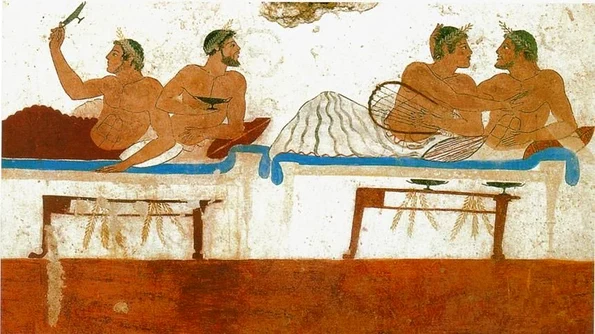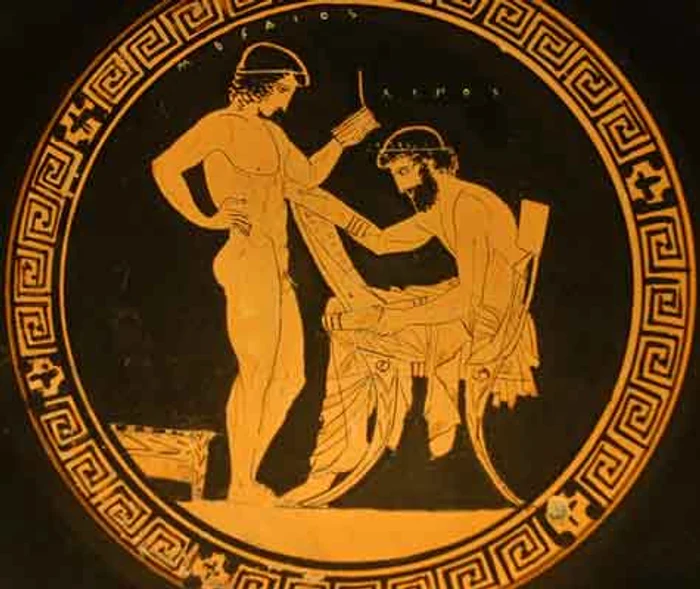
Sexuality in Ancient Greece: a Mark of Social Status?
The politics of sexuality, by which we mean the various erotic activities involving women, free men, slaves, strangers or mythological characters, activities very vividly depicted on ceramics, is an old topic in classical studies. The main question of this subject matter is how physicality contributed to the establishment, stability or violation of social rules and hierarchies in the human network. To what degree and why were such affairs a public concern, affairs that today belong to the private area?
It is not enough to associate the highly explicit sexual imagery of the Greek and Roman world with some sort of predecessors to modern magazines. But yes, one would easily find calendars with erotic depictions for sale, from Sparta to Samos, but they fulfilled a well defined social purpose. Analyzed in their originary context, these images somehow ensured the strict observance of social and political boundaries, also serving as a basis for the age-specific morals.
Let us cast an eye upon the Athenian art in the fifth century BC democracy, democracy meaning the exclusion of women, slaves and strangers. Such a polarization between the ones that had access to public affairs and the outsiders reminds us of a famous phrase, a mark of Athenian identity:“I am not a slave, I am not a stranger, I am not a woman”. There functioned a logic of separation, a definition ex negativo that implied focusing on an expression of citizenship as clear as possible, so as to gain an identity. One occasion that marked in pretty brutal way this distinction between identity and alterity was the symposion, a ceremonial tradition dedicated exclusively to men, when they drank, played games and engaged in sexual intercourse with prostitutes or younger men. The symposion fortified the idea of citizenship, and iconography spoke volumes about it as well
Potters and painters from Athens produced clay bowls of all sizes that served various purposes and were decorated with equally various scenes, ranging form mythological stories to everyday life representations. The erotic images on the stoneware portrayed characters of all social categories in many positions and against many backgrounds. The man, the citizen, looked at them and gained information about how and what he was supposed to do to maintain his identity and distance from “the other” (women, slaves, strangers). To put it briefly, the viewers were offered the correct sexual activities according to their position in society and their aspiration to become the role model citizen. It was a speech on morality through visual representations.
As for women, they were inferior to men, politically speaking, but they played an essential part in procreating the future Athenian citizens. This maternal role would have somehow been threatened by an alleged feminine promiscuity, an innate vice. According to medical records, which are however posterior to the boom in erotic representations, this alleged promiscuity was determined by acute sexual instincts and the impossibility to control them…In the 6thand the first half of the 5thcentury depictions on ceramics were highly stereotypical, augmenting a perspective of feminity as a mark of “otherness”. The lack of feminine rationality is best illustrated in stories about Amazons, who displayed an extraordinary violence. Not only Amazons were represented in the fighter state, but also once normal women who defied nature so much that their bodies developed masculine organs.

There are numerous sexual hypostases for women, meant to underline their insatiable lust. An even more intriguing aspect is that we cannot really draw a very clear line between representations of prostitutes and representations of wives. Sometimes we have hints such as a small bag of money or a pornographic graphitto, but not always.
Another recurring theme is masturbation, mostly attributed to slaves. Among the sexual toys we can even find the amphorae, a metaphor of women’s impossibility to become citizens being their clumsiness at handling the dish. The vilification of the inferior sex continues through the not so few scenes of sapphism or zoophilia. When underscoring such practices, men were actually legitimizing the women’s low political and social status and attention was also drawn to what men must refrain from in order to preserve the benefits of citizenship.
Slaves, besides the onanistic obsession, were thought of as beastly creatures, owning a huge phallus, an endowment that clearly defied Greek norm that considered it a mark of brutality, of the “otherness”. A big phallus did not mean masculine pride at all, on the contrary, it hinted at an inferior status. As evidence we have a whole constellation of statues representing nudes with minimalized organs.
To cap it all, athletes used infibulation to maximize their performances and attractiveness. Barbarians also had a deflective behavior. Very often the Greeks scorned them for their emasculation. Assimilated to the image of women, Persians or Scythians were depicted in non-dominating sexual poses if the partners were Greeks, and if their partners were barbarians, the poses seemed too acrobatic and unnatural for true masculine characters. Therefore, the sexual iconography of “the other” helped build an role model for the Athenian man. At the same time, other images serve as recommendations for the sex life of the Greeks.
As for the relationships with women, there was a strict boundary between the perspectives upon prostitutes (hetaerai) and wives, but that was, as mentioned before, not very clearly marked visually. The wives’ depictions were not that diverse:usually they were waiting for their men to come home, or they were carrying stoneware, so generally a household imagery. In mythological depictions they were often victims of rape, but then again, normal marriages were not quite the rule in this type of iconography. As for the hetaerai, they appeared to be in the dominant position in their relationships with men, and next to them artists sometimes represented bags with gold to suggest the profession. Scenes involving orgies were also common.
Citizens also got involved with other men, eromenoi, the young boys who did not yet earn the citizenship, the partners could, unlike Rome, be citizens as well. In this case the domineering position was constantly negotiated because the penetrated one was in a womanly state, invoking all the inferiority complexes associated with it. At least on ceramics the pose was that of interfemural sex, so that none of the partners could be socially denigrated.

In this way the images on the pots used at the symposia probably mirrored events that actually occurred. Or they could have acted as catalysts. But, most importantly, they alluded to a mentality and a socio-political structure associated with certain sexual behaviors that contributed to drawing clear lines between the Athenian citizen and other less important categories from the periphery of society. The citizen must always find himself in the dominant position, including the sexual level.
However, boundaries can not always be clearly defined. In this strict conceptualization of the erotic area there comes in sight the satyr. Half horse/goat, half human, with and enormous erect phallus, this figure was incredibly popular on 6thand 5thcentury ceramics. The satyrs were part of Dionysus’ suite, dancing and tanking up on wine on every occasion, pretty familiar habits to the Athenian citizens who took part in the symposia. Nonetheless, these creatures also symbolized a series of behaviors that had to be avoided:they masturbated a lot, they tied up objects to their phalli, they dressed like strangers, they abused animals. The figure can be double interpreted. Either the satyr renews the aformentioned behavioral frontiers, or on the contrary, it shows how easily they can be broken. Its sexual zeal may hint at the easiness of breaking the socially accepted sexuality.
Deflections from the sexual code can also be related to the political context. For instance, during the Persian wars the iconography of the age depict citizens who are all but honorable, engaging in zoophilia or defecating at symposia. That meant that the normal, well established citizen might as well join the other side of the fence, becoming less human. Erotic distinctions have their dose of ambiguity. By the end of the 5thcentury, satyrs begin to look more and more like Athenians, the antithesis diminishing up to the point that the creatures imitate heroes like Heracles or Perseus.
They also take after women or slaves, cooking, taking care of animals or carving sculptures. The satyr was the image of everyone, casting a shadow upon the differences between social categories. Filling up parts of great variety, it functioned as a binder of all the classic images of sexuality in ancient Greece and questioned the definition of identity and alterity. For instance, there is a goblet that on one side depicts the image of a satyr. The foot of the goblet is shaped like male organs. When drinking from it, the face of the satyr on the opposite side covered the drinker’s face, so he basically turned into a satyr, metaphorically speaking. A visual example of uncertain sexual frontiers.
In conclusion, the imagery promoted on Athenian stoneware structures but at the same time defies the attempt to define citizens and non-citizens according to sexual practices. The line between “self” and “the other” is permanently negotiated. The Greek must look at and analyze the erotic images to see where they fit and how they can be identified based on private morals, which are a milestone for social positioning, albeit not an absolute one.
We recommend:
Michael Scott, “How, Where and with Whom:The Politics of Sex in Ancient Greece”, Cambrigde, 2004;
R.F. Sutton, The Good, the Base and the Ugly:the Drunken Orgy in Attic Vase Painting and the Athenian Self”, in “Not the Classical Ideal:Athens and the Construction of the Other”, Boston, 2000.















